Wild guinea pigs are found in the grasslands and mountains of Brazil, Peru, Uruguay, and Argentina. They look almost the same as their domesticated counterparts. These guinea pigs are herbivores.
Wild guinea pigs love eating flowers, grass, leaves, and almost everything that grows on the ground. Clover and dandelion leaves are a special treat for wild guinea pig’s taste and enjoyment. By knowing wild guinea pig’s habitat, behavior and diet, we can better understand domestic guinea pigs and their needs.
Table of Content
What Are the Wild Guinea Pigs?
This is the list of some of the wild guinea pigs:
Brazilian Guinea Pig
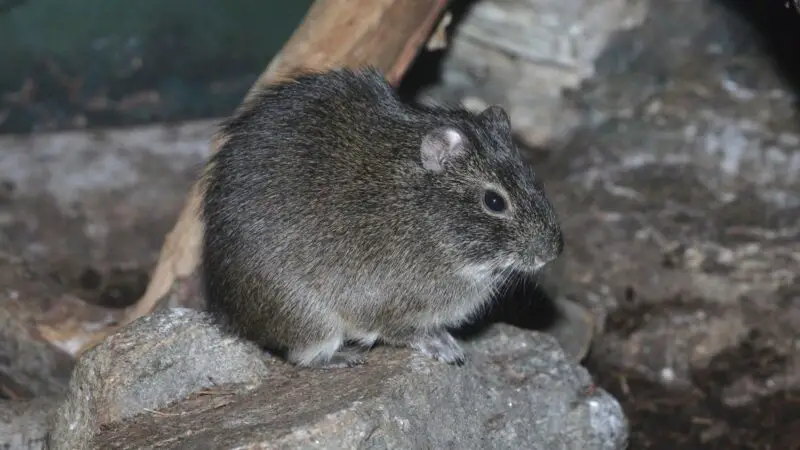
- Scientific Name: Cavia aperea
- Physical appearance: Medium herbivore guinea pigs. They weigh an average of 637 g and vary in size from 520 to 795 g.
- Habitat: Found in the Andes highlands, their natural habitats are scrub grasslands and savannas. They prefer places with dense ground cover.
- Lifespan: up to 8 years (wild); up to 10 years (captive)
- Diet: Specialist grazers that only eat plants. True grasses are their main source of food.
Moleques Do Sul Guinea Pig
- Scientific Name: Cavia intermedia
- Physical appearance: Have longer hair around the neck and long, coarse fur that is often gray or brown. They have short, hairless limbs, stocky, cylindrical bodies, and no external tail.
- Habitat: Grasslands
- Lifespan: 2.4-16 months (wild); 8 years (captivity)
- Diet: Mainly leaves of grasses
Greater Guinea Pig
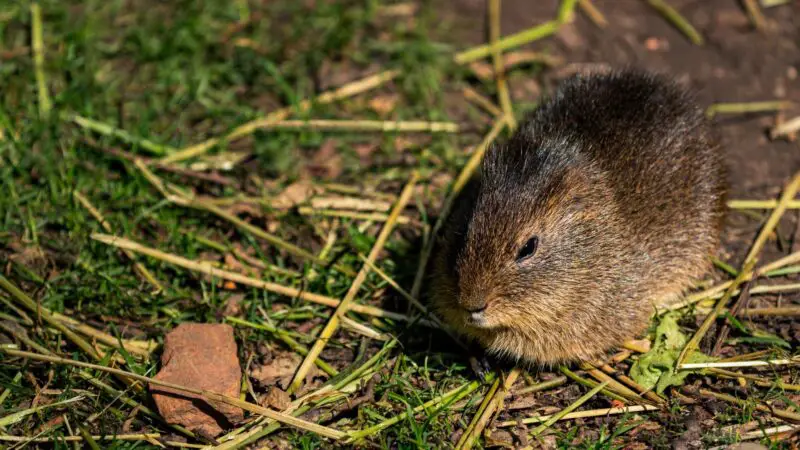
- Scientific Name: Cavia magna
- Physical appearance: For males, their length is 310 mm and weight of 636 g. For females, their length is 303 mm and weight of 537 g. Dark agouti brown colors covers the dorsal fur, while reddish brown covers the underparts.
- Habitat: Eastern Uruguay and Southeastern Brazil. Its usual habitat includes wetlands, damp grassland, the borders of forest, and tiny valleys.
- Lifespan: On average, 5-6 years
- Diet: Grasses, green plants
Montane Guinea Pig
- Scientific Name: Cavia tschudii
- Physical appearance: A medium-sized breed that reach a length of 247 mm. Their color differs based on where they are found. For instance in Peru, their underparts are dark buffy-grey in color, and the dorsal hair is a dark reddish-brown mixed with black.
- Habitat: Andes in South America, Peru Southward to the Tarapacá Region of Chile and the Tucumán Province of Argentina
- Lifespan: 3-5 years (wild); 8 years (captivity)
- Diet: Grasses
The Difference in Domestic and Wild Guinea Pigs
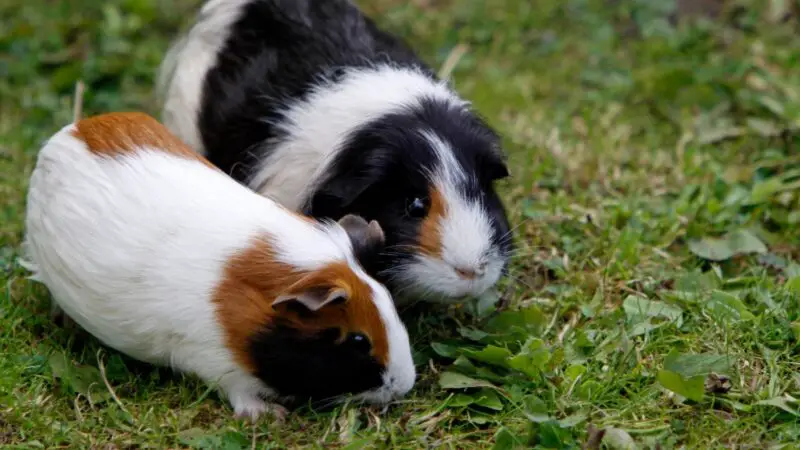
Guinea pigs in the wild are quite different from domestic guinea pigs in various contexts. The range of factors differs such as their emotions, exploration and anxiety, social attraction, stress levels, social behavior and psychological adaptations.
However, despite the differences in behavior, wild and domestic guinea pigs are herbivores, they require the same diet and look for the same kind of food.
Wild Guinea Pig Diet: Information
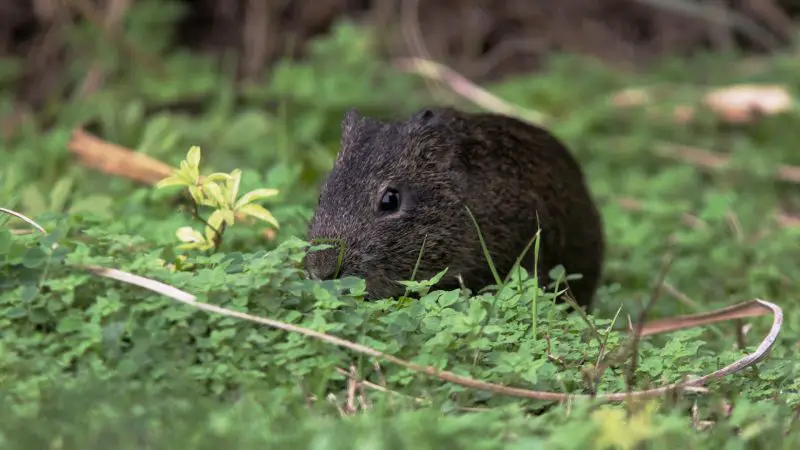
Guinea pigs are herbivores and they don’t eat meat. Wild guinea pigs don’t eat processed pellets unlike domestic guinea pigs to stay healthy. In the wild, they eat all types of grasses, wild vegetables and fruits, herbs, flowers, leaves but also in some cases stems, roots, seed, barks, and so on.
They don’t drink water if they eat foods with higher water content. Guinea pigs eat wild plants that they know are safe to eat, including chickweed and dandelion leaves. They adapt to their environment and they learn which foods they should avoid. Guinea pigs are also fond of eating fresh grass.
Being herbivorous animals, they eat plants and similar food items only to gain all the necessary nutrients needed for their survival. Wild guinea pig’s natural diet is full of vitamin C, which is of the extreme importance in order to live healthy and to survive effectively.
What Wild Plants Can Guinea Pigs Eat?
Most of the wild guinea pigs eat fresh grass and seasonal food for their diet from spring to fall. During the winter season, they tend to prefer wild vegetables.
Guinea pigs find fresh herbs, leaves and even small branches that they use to wear down their teeth. The following are some of the most common foods or plants that guinea pigs eat in the wild.
Grass, Leaves and Flower
The lush green grass is the favorite food of guinea pigs all over the world. A nice handful of lush green grass is a great snack for their appetite. While grazing in the wild, coming across poisonous plants is inevitable.
Eating a dangerous plant along with the thick grass could damage their health. They enjoy eating flowers, but buttercups and daisies are especially problematic. This is where their sense of smell works for them. They sniff the grass or flowers and eat which they deem safe.
Mown grass is considered dangerous for guinea pigs’ health as it contains fungus and disguised poisonous plants that have the potential to cause fatal conditions of bloating.
Wild guinea pigs also eat tree leaves as they are very nutritious for them, but there are also some leaves that can be poisonous to guinea pigs, such as ivy and oak tree leaves.
Fruits and Vegetables
Fresh fruits and vegetables are necessary for any guinea pig’s diet. They eat veggies and fruits in the wild to fulfill their nutritional intake of essential nutrients and vitamins. Guinea pigs drink water that is easily available to them in the wild. They also eat salad vegetables that contain water.
Guinea pigs like eating wild strawberries, wild blueberries, wild raspberries, dandelions, elderberry, wild black cherry, wild apples, wild asparagus, root vegetables, dark green leafy vegetables and many other vegetables and fruits that they can find in the wild.
Fruits are acidic in nature, and over-consumption can lead to the formation of sores around guinea pigs’ mouth.
Eating Patterns of Guinea Pigs in the Wild
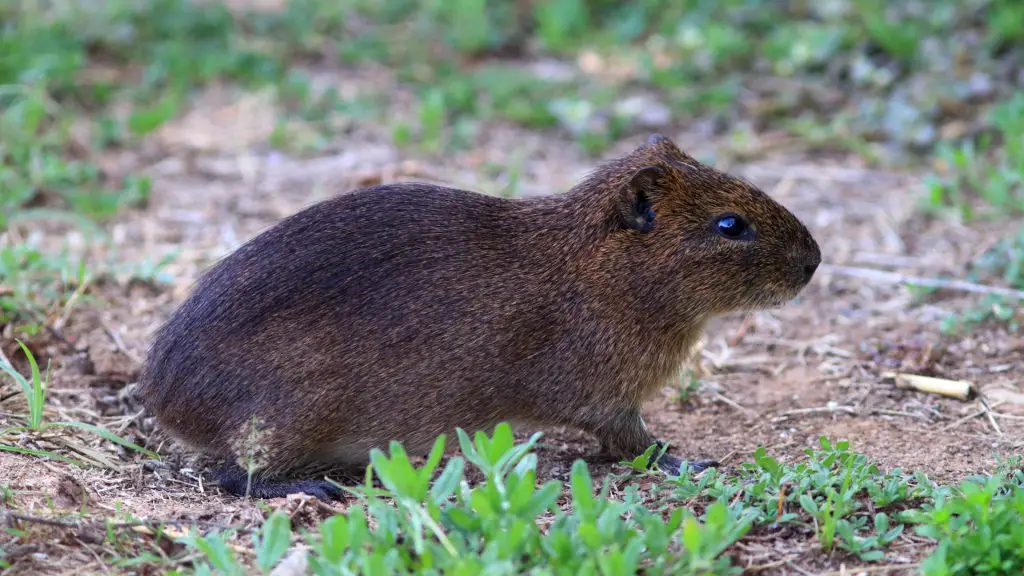
Guinea pigs graze constantly instead of eating a large quantity of food at once. They normally do this in the twilight hours, when there is less chance of predators being around.
They tread firmed paths that are used to get between their burrows and food sources. In the wild, they can also be spotted in a mass gathering, when many guinea pigs are in the same area with abundant food.
Guinea Pig Diet Preference in the Wild
Guinea pigs like to eat a vegan diet and eat almost everything that grows on the ground. Living amidst nature gives them access to a huge variety of plants that guinea pigs like to eat.
In the wild guinea pigs like to eat food that is rich with vitamin C and also food with enough amount of water. Especially, they love to eat wild clover, chickweed, and dandelion leaves.
Guinea pigs that live in the wild follow their instincts and eat what grows on the ground. But, because of predator risks, sometimes they need to eat some foods that we don’t give to domestic guinea pigs, like branches, seed, barks, and so on.
What Foods Guinea Pigs Avoid in the Wild?
A guinea pig’s digestive system is quite sensitive. They are fickle eaters of fruits and vegetables, but there are some fruits and vegetables that are not safe for guinea pigs.
Both wild and domestic guinea pigs can’t eat onions and garlic. Wild onion and wild garlic can cause some stomach problems for wild guinea pigs and this is why they will avoid it every time.
When it comes to wild mushrooms, guinea pigs also can’t eat wild mushrooms, because there are many wild mushrooms that are poisonous both for guinea pigs and for humans.
They don’t eat any kind of meat in the wild, and gassy foods and plants that contain oxalic acids in high amounts can be specifically problematic for guinea pigs.
Some plants that guinea pigs avoid in the wild are ivy and oak tree leaves, wild celery, wild rhubarb, buttercups, daisies and others.
Guinea Pig’s Wild Habitat
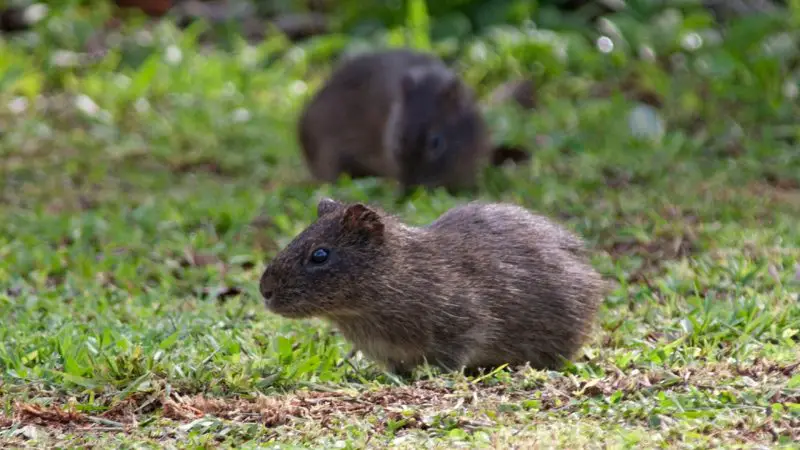
Wild guinea pigs are found in large numbers in the grassy plains of Columbia, Brazil, Ecuador, Peru, and Bolivia. They enjoy digging themselves underground and co-exist in groups. Wild guinea pigs are very social and their small groups most often consist of one male, one or two females and their young, which are called pups.
Pups are usually born with open eyes and with hair. Right from the time of their birth, they are able to run and eat solid foods. Survival abilities of pups decrease the mortality rate among guinea pigs.
Wild guinea pigs need to be aware of predators as they like roaming and running in the open mountains and cherish their freedom. They use whistles to notify other group members about any danger in the same vicinity. Because of danger, guinea pigs are crepuscular animals that tend to be most active during dusk and dawn when it is harder for predators to find them.
Guinea pigs usually find hiding places or tunnels that are formed by vegetation and they move only in the small groups when searching for food and it is important to note that they don’t store their food.
Can Guinea Pigs Survive in the Wild?
Guinea pigs can survive in the wild because they live in herds and they have a well-developed survival instinct. They find shelters and are most active early in the morning and in the evening when there are not that many predators.
Also, guinea pigs usually will go only a few meters away from their cover zone in order to search for food. Their covers are always in close proximity to the food source.
Guinea pigs can survive in the wild for up to 8 years. But because of the high risk of predators, their average lifespan in the wild is only around 3 years, which is two times less when we compare them to our domestic guinea pigs.
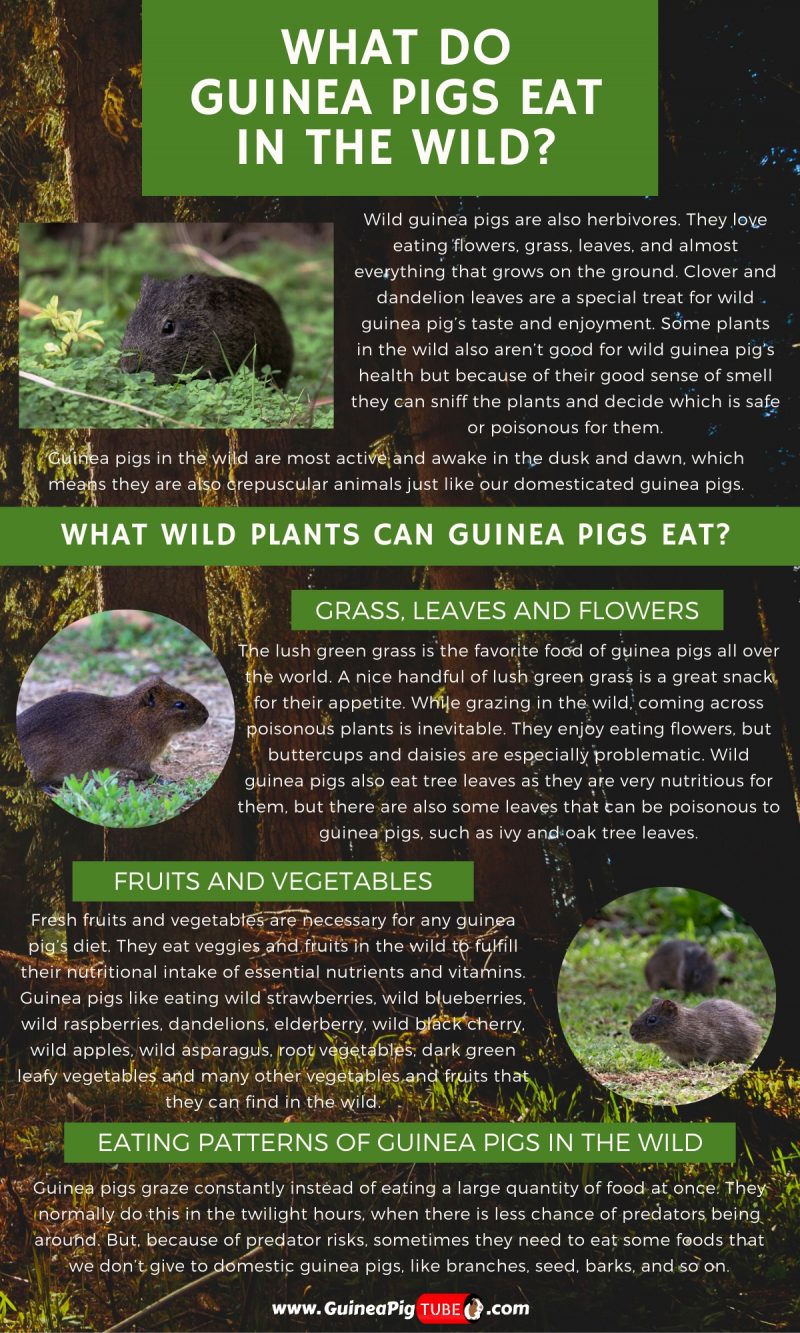
Summary
Guinea pigs learn what to eat and what not to eat in the wild during their early life. These habits are difficult to change after maturity. They don’t respond well to a sudden change in their diet.
Even if these guinea pigs live in the wild, they look almost the same as our cute pets. Hopefully things are now a little bit cleared when it comes to guinea pigs and their life in the wild.
List of Sources
Diet Changes Alter Paternally Inherited Epigenetic Pattern in Male Wild Guinea Pigs
Foraging Under Predation Risk in the Wild Guinea Pig Cavia Aperea
Social System and Spatial Organization of Wild Guinea Pigs (Cavia Aperea) In a Natural Population
